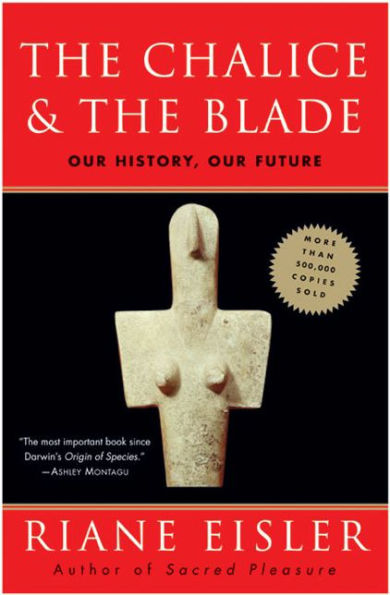Read an Excerpt
Chapter OneJourney into a Lost World:
The Beginnings of
Civilization
Preserved in a cave sanctuary for over twenty thousand years, a female figure speaks to us about the minds of our early Western ancestors. She is small and carved out of stone: one of the so-called Venus figurines found all over prehistoric Europe.
Unearthed in excavations over a wide geographical area—from the Balkans in eastern Europe to Lake Baikal in Siberia, all the way west to Willendorf near Vienna and the Grotte du Pappe in France—these figurines have been described by some scholars as expressions of male eroticism: that is, an ancient analogue for today's Playboy magazine. To other scholars they are only something used in primitive, and presumably obscene, fertility rites.
But what is the actual significance of these ancient sculptures? Can they really be dismissed as the "products of unregenerated male imagination"?1 Is the term Venus even appropriate to describe these broad-hipped, sometimes pregnant, highly stylized, and often faceless figures? Or do these prehistoric sculptures tell us something important about ourselves, about how both women and men once venerated the life-giving powers of the universe?
The Paleolithic
Along with their wall paintings, cave sanctuaries, and burial sites, the female figurines of the peoples of the Paleolithic are important psychic records. They attest to our forebears' awe at both the mystery of life and the mystery of. death. They indicate that very early in human history the human will to live found expression andreassurance through a variety of rituals and myths that seem to have been associated with the still widely held belief that the dead can return to life through rebirth.
"In a great cavern sanctuary like Les Trois Frères, Niaux, Font de Gaume or Lascaux," writes the religious historian E. O. James, "the ceremonies must have involved an organized attempt on the part of the community . . . to control natural forces and processes by supernatural means directed to the common good. The sacred tradition, be it in relation to the food supply, the mystery of birth and propagation, or of death, arose and functioned, it would appear, in response to the will to live here and hereafter."2
This sacred tradition found expression in the remarkable art of the Paleolithic. And an integral component of this sacred tradition was the association of the powers that govern life and death with woman.
We can see this association of the feminine with the power to give life in Paleolithic burials. For example, in the rock shelter known as Cro-Magnon in Les Eyzies, France (where in 1868 the first skeletal remains of our Upper Paleolithic ancestors were found), around and on the corpses were carefully arranged cowrie shells. These shells, shaped in the form of what James discreetly calls "the portal through which a child enters the world," seem to have been associated with some kind of early worship of a female deity. As he writes, the cowrie was a lifegiving agent. So also was red ocher, still in later traditions the surrogate of the life-giving or menstrual blood of woman.3
The main emphasis seems to have been on the association of woman with the giving and sustaining of life. But at the same time, death—or, more specifically, resurrection—also appears to have been a central religious theme. Both the ritualized placement of the vagina-shaped cowrie shells around and on the dead and the practice of coating these shells and/or the dead with red ocher pigment (symbolizing the vitalizing power of blood) appear to have been part of funerary rites intended to bring the deceased back through rebirth. Even more specifically, as James notes, they "point to mortuary rituals in the nature of a life-giving ritual closely connected with the female figurines and other symbols of the Goddess cult."4
In addition to this archaeological evidence of Paleolithic funerary rites, there is also evidence of rites seemingly designed to encourage the fecundity of the wild animals and plants that provided our forebears with life support. For example, in the gallery of the inaccessible cavern of Tuc d'Audoubert in Ariège, on the soft clay floor underneath the wall painting of two bisons (a female followed by a male), we find impressions of human feet believed by scholars to have been made in ritual dances. Similarly, in the Cogul rock shelter in Catalonia, we find a scene of women, possibly priestesses, dancing around a smaller naked male figure in what seems to be a religious ceremony.
These cave sanctuaries, figurines, burials, and rites all seem to have been related to a belief that the same source from which human life springs is also the source of all vegetable and animal life—the great Mother Goddess or Giver of All we still find in later periods of Western civilization. They also suggest that our early ancestors recognized that we and our natural environment are integrally linked parts of the great mystery of life and death and that all nature must therefore be treated with respect. This consciousness—later emphasized in Goddess figurines either surrounded by natural symbols such as animals, water, and trees or themselves partly animal—evidently was central to our lost psychic heritage. Also central to that lost heritage is the apparent awe and wonder at the great miracle of our human condition: the miracle of birth incarnated in woman's body. Judging from these early psychic records, this was a central theme of prehistoric Western systems of belief.
Now what we have been developing to this point is still not the view of many scholars. Nor is it the view still taught in most survey classes about the origins of civilization. For here, as in most popularized writings on the subject, there still prevail the preconceptions of earlier scholars who saw Paleolithic art in terms of the conventional stereotype of "primitive man": bloodthirsty, warlike hunters, in fact very unlike some of the most primitive gathering-hunting societies discovered in modern times.5



